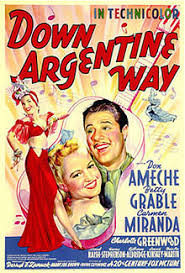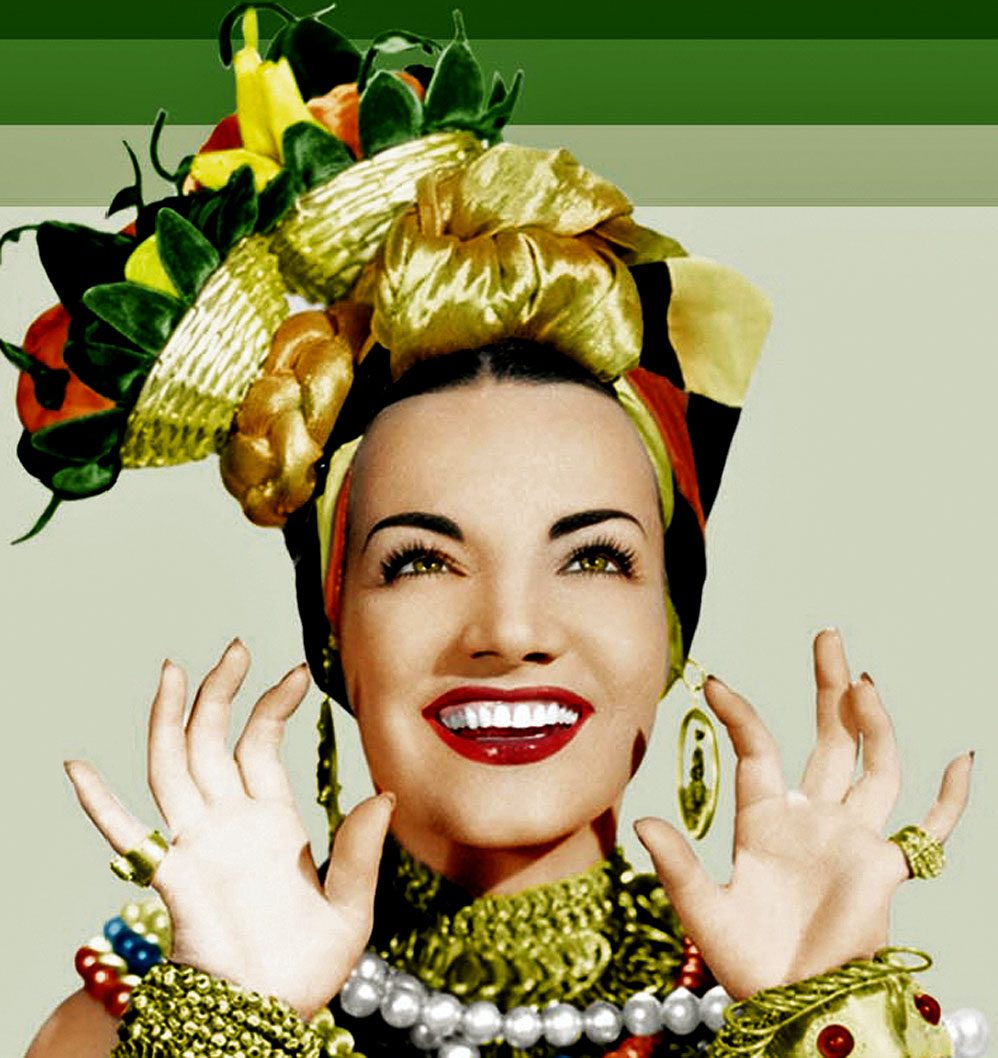Down Argentine Way (1940): The appropriation of the other’s culture

Down Argentine Way, directed by Irving Cummings, is a declaration and an attempt to seduce the Latin American by creating an Argentine theme movie while misrepresenting their culture. There is a lot of talk in cultural classes about authenticity or the proper representation of other cultures. And, in Down Argentine Way is clear that the director and his team did not make an effort to include actual Argentine music, clothing, or even dancing routines that could reflect the ‘authentic’ folklore of this nation. It is important to remember that by 1940, the Argentine cinema was well-established in Latin America and movie theaters where all over the capital, so I would imagine that when they saw this movie misrepresenting their country and its traditions (which they saw as a cultural travesty), pushed to boycott it.
The movie begins with the iconic Carmen Miranda dancing at the tune of a typical tropical ‘Tutti Frutti Hat’ type of song. The appearance of Carmen Miranda marks the tone for which the viewer should identify with this movie about Latin America. Furthermore, Carmen Miranda serves as a cultural homogenizing marker which indicates that all Latin countries are the same and that cultural or geographic specificity doesn’t really matter. Perhaps what really matters in the movie is the pretend good-neighbor policy of integration and cooperation designed by the Americans. This is not to mention that by 1940 the Argentine government (as well as the Brazilian) was being seduced by the Axis forces and the USA saw to change this sphere of influence on their favour. Just like Phil Swanson in his article, “Going Down on Good Neighbours” explains, Down Argentine Way was made to represent glamour and good fortune for some, the content of the film sets South America to be a paradise free of war, while many were suffering and dying everywhere else. Hence, somehow, Down Argentine Way is a historical misrepresentation where Americans can escape from reality and find their own oasis in Argentina (or anywhere else in Latin America) as a way to run away from the calamity of war.
Down Argentine Way also points out to a new era of transatlantic communication and transportation. For instance, in one of the first scenes, the Argentine horses are moved into a cruise ship. The image reads, “Argentine-Pan American Lines” showing a direct way of international maritime transportation route from Buenos Aires to New York. Technology, integration and business all collide in this movie as a way to international integration among the developed North and the developing South. The feud between two families also are also part of the main plot of the movie. The Argentinian family represented by Mr. Quintana and the American Family represented by Ms. Binnie Crawford do not have a good relationship. But at the end of the movie, these two families are reconciled and become good-neighbors which favours the commercial trade among them. Hence, hinting that no matter the differences and difficulties among these two nations (USA and Argentina), a ‘beneficial’ solution can be achieved in the end.
The music and dancing of the movie, Down Argentine Way, also symbolizes the misrepresentation and cultural appropriation done by Hollywood. In fact, the Spanish songs are replaced by English ones. The tropical Spanish drums take over Glenda, the main female American character, as she starts suddenly dancing and even singing in English first and then in Spanish (Language does not need to be learned just felt?). It is like the music possess her and she cannot longer be a rational American woman. Nevertheless, this order is restore when the English band starts singing again and Glenda gets herself together in order to sing again more calmly. There is also another music scene where there is a sort of match-up between the American singing band and a tropical drum Latino band. However, their appearance and placement on the screen shows them in different planes of impotence. The English tuxedo music band is located at the center-top part of the screen while the drum Latin American music band is sitting down at the bottom/feet of the American band. This arrangement servers to illustrate the perception that America is always first: culturally, artistically and even commercially. On the other hand, the idea of the Latin Lover and all the romantic skills that he possess in the movie, represented by the character Ricardo Quintana, also are used as a secret code language to provide access unexplored sexual pleasure in a mutual transaction. It seems that the Argentinian horses and its men are also equally misinterpreted or word-coded to be of the same caliber. Here, Down Argentine Way makes an animalistic assumption which equal to sexual pleasure (getting yourself a man) could be the same as buying a horse.
Finally, the fiesta celebration that Ricardo and Glenda seem to run into when they are preparing for the horse raising, lacks cultural specificity. This fiesta has more to do with a Mexican celebration than with an Argentine get together. There is no tangos being played here. The clothes of the peasant girls are wrong and the gaucho’s all have the same style costumes. What’s more, when one of the Argentinian girls is dancing frantically in the center of a crowd of people, she gives her place to Binnie Crawford: an American. Somehow the American, represented by Binnie here, take over the Argentinians in their own backyard and displace them. Ms. Crawford then steals the show and takes over their music, dancing, singing, and even their men and horses. In this bilateral commercial transaction, the Americans are the ones who always win and the Argentinians (and for that matter all the Latin Americans) are there as mere fillers who can be convinced or bought easily.
Hence, Down Argentine Way is a clear example and the epitome of misrepresenting other people’s culture expression for your own entertainment and pleasure with little or no consequence. Way to go Hollywood!

